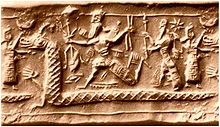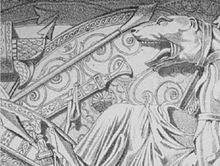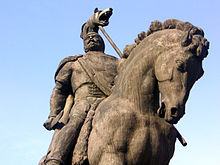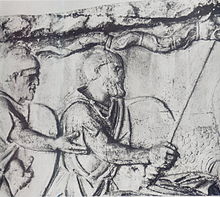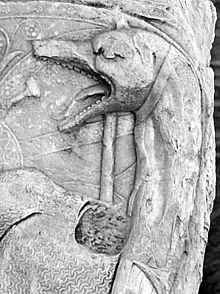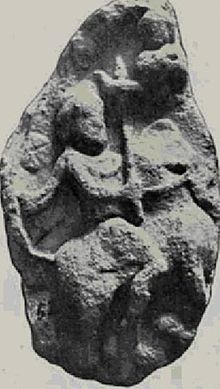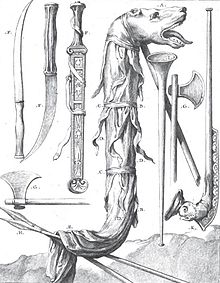- Dacian Draco
-
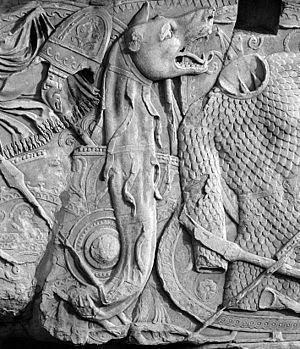 Dacian Draco as from Trajan's Column
Dacian Draco as from Trajan's Column
The Dacian Draco was the standard and ensign of troops of the ancient Eastern European Dacian people, which can be seen in the hands of the soldiers of Decebalus in several scenes depicted on Trajan's Column in Rome, Italy. It has the form of a dragon with open wolf-like jaws containing several metal tongues.[1][2][3] The hollow dragon's head was mounted on a pole with a fabric tube affixed at the rear. In use, the draco was held up into the wind, or above the head of a horseman, where it filled with air and gave the impression it was alive while making a shrill sound as the wind passed through its strips of material.[4][5][3]
Contents
Name and etymology
Draco (Latin) and Drakon (Greek) mean "serpent", "dragon". The root of these words means “to watch” or “to guard with a sharp eye”.[6] Apparently, it is a derivative of Greek drakōn "gazing" .[7]
Origins
The origin of the standard is unknown and still a matter of dispute among scholars. A certain origin is still difficult to be determined, but Thracian, Scythian, Sarmatian[8][9][10] or Parthian origins have been proposed in dedicated historiography.[11] However according to Lucreţiu Mihăilescu-Bîrliba, by the 2nd century AD, i.e. after the conclusion of the Dacian Wars, the draco symbol was assimilated in the Greco-Roman world with the Dacian ethnos.[12]
Significance
Assyro-Babylonian demon Tiamat
Among the Dacians, the draco was undoubtedly seen by the army as a special protective symbol, while it also played an important role in the religious life of the people.[3]
The draco shows a religious syncretism between the wolf and the dragon as well as the serpent. It was supposed to encourage the Getae and to scare their enemies.[13]
- A wolf was depicted at the standard's head, symbolic animal of the Carpathian people since the phase B of Hallstatt Period (10th–8th century BC). The animal is shown in an aggressive posture similar to that of the Assyro-Babylonian demon Tiamat (see below images gallery) or the Hittite monsters.[14] The religious association of the dragon with the wolf or the lion is first found around the year 1120 BC, on a stela of Nebuchadnezzar I, where an exact representation of the symbol of the Dacian dragon is found in the fourth quarter.[14] This indicates that the Dacian draco stems from the art of Asia Minor where the religious-military symbology of dragon extended both eastward to the Indo-Iranians and westward to the Thraco-Cimmeriano-Getians/Dacians.[15][14]
By the time of the phase D of Hallstatt Period (8th–6th century BC), the decorative pattern of a dragon head or a serpent had become quite common in Dacia. In the La Tène Period (3thBC–1st century AD), it served as a standard for the Dacians. [16] The image of the draco appears on a 4th century BC ceramic piece discovered at Budureasca commune, Prahova county, Romania. [17][18]
- The body of the standard, depicting a dragon-like balaur or a large snake, was seen by the Dacians as a manifestation of the sky demon or "heavenly dragon".[19][20] This relates to their supreme god Zalmoxis who was a sky god (cf. also Tomaschek[21]).[22] In the Hallstatt Period "proper", the decorative pattern of a dragon head or a serpent became quite common in Dacia. The dragon symbol is also represented on the silver Dacian bracelets of the Classical period.[23] The snake-shaped bracelets and other similar ornaments show not only the spread of the snake as a decorative motif but also its significance in Dacian material civilization.[24][25]
Dacian Draco in warfare
Dacians marched into the battle accompanied by the howl of boar-headed trumpets and following their sinister multicolored dragon-head standard. As intended, they made a terrifying audiovisual spectacle.[26][27]
The draco first appears on Trajan's Column in Rome, a monument that depicts the Dacian wars of 101–102 AD and 105–106 AD. German historian Conrad Cichorius notes that, even though Dacians carry the draco, it was called the Scythian draco in Arrian's Tactica written around 136 AD.[28] According to Ellis Minns, the dragon standards of the Arrian were those of the Dacians.[29]
Representations of the Dacian Draco
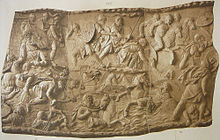 Draco is borne by Dacian cavalry crossing the Danube (Trajan's Column)
Draco is borne by Dacian cavalry crossing the Danube (Trajan's Column)
Trajan's Column in Rome
On Trajan's Column (113 AD) Dacian soldiers are represented carrying a draco in 20 scenes. One depicts the draco borne by Dacian cavalry crossing the Danube by swimming with their horses.[3] In another, the draco is planted in the center of a Dacian citadel and surrounded by the skulls of several Roman prisoners.[3] On Trajan's Column the draco is the symbolic image of victory although it is absent from pictures on the column that illustrate Trajan's second war against the Dacians, when the Romans conquered Dacia.[3]
Roman coins of Dacia
The draco appears on coins of Roman Emperor Antoninus Pius (r.138–161 AD), indicating that it was still the characteristic emblem in the second century.[30]
Arch of Galerius in Thessaloniki
The characteristic Dacian dragon emblem is carried by a group of Dacian horsemen depicted on the Arch of Galerius and Rotunda in Thessaloniki, Greece.[31]
A Funerary Sculptured Monument of Chester
A draco (considered in 1955 by R. P. Wright of Dacian or Sarmatian type) is depicted on a large stone found at Deva Victrix (Chester, UK) in the North Wall (West) in 1890.[12] The dragon flag is represented horizontally, as held by the cavalryman but its head is not visible, because the stone is rather deteriorated. Most scholars consider the horseman is a Sarmatian, wearing a Sarmatian helmet and carrying a Sarmatian standard.[9] According to Mihăilescu-Bîrliba (2009) the depiction of the Dacian standard is certain and similar representations can be observed on the most important monuments of the Roman triumph over Dacians.[32] A military diploma (dated to 146 AD) found at Chester mentions among the units of the released soldiers the name of cohors I Aelia Dacorum.[33] Therefore, the horseman depicted on the tombstone at Chester could be a Dacian cavalryman, belonging to the cohors Aelia Dacorum (or more precisely to an vexillatio of that cohort).[34] P. A. Holder suggest that the cohort was created in 102 or a little earlier, with Dacians settled in the Empire, and it received the name of Aelia later.[33]
Dacian Draco as adopted by the Roman army after 106 AD
The so-called Danubian Riders-God or Dacian Riders-God (object from maybe 2nd century AD, Bucharest Antiquities Museum) bears a draco.[35]
The first sculptural representation of a draco borne by a Roman soldier dates from the time of Emperor Marcus Aurelius (r.161 to 180 AD).[36]
Scholars believe that the draco was adopted by the Roman army following their conquest of the Dacians.[5][37][38] It became the standard of the cohort in the same way that the aquila or Imperial eagle was the standard of the Roman legion. [37] The adopted standard in the Roman cavalry was borne by a draconarius. Later, the draco became an imperial ensign.[39]
The draco was specific not only to Roman occupied Dacia but also to the Sarmatian and Parthian regions. As a result, some alternative origins for the Roman army's draco have been proposed.[36] According to Franz Altheim[40], the appearance such ensigns in the Roman army coincided with the recruitment of nomad troops from central and southern Asian, and it was from this region that the image passed into China, Iran and subsequently to the West. The Dacians and Germans would then have inherited it from the Sarmatian people.[36]
Compared to those of the Dacians and Romans, the Sarmatian Draco was more Oriental in appearance with prominent ears, dog-like teeth and even fins.[41] It did not usually have scales or the distinctive crest of the dragon-like gilded head of a late Roman standard found at Niederbieber, Germany.[41] Its head may have been represented by the legendary Iranian senmurv — half-wolf, half-bird.[41]
Regardless its origin, Mihăilescu-Bîrliba (2009) suggests that at the end of the 1st century A. D., the Romans associated the draco with Dacians.[42]
Votive tablets
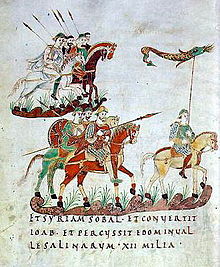 Carolingian cavalrymen from the 9th century with a draco standard
Carolingian cavalrymen from the 9th century with a draco standard
 Dacian Draco on the coat of arms of Cluj-Napoca
Dacian Draco on the coat of arms of Cluj-Napoca Dacian Draco from Trajan's Column by Michel-François Dandré-Bardon
Dacian Draco from Trajan's Column by Michel-François Dandré-Bardon
A draco banner is carried by one of the Danubian Riders, native Dacian deities, on a Danubian plaque ascribed to the first two decades of the fourth century.[43] Because of the great importance of this symbol in the religious and military life of the Dacians, some writers believe that the draco must have been directly adopted and reproduced on the so-called Danubian plaques dating to the 3rd–4th centuries AD.[3] According to some researchers such as Dumitru Tudor, the presence of this military ensign on the Danubian plaques is explained simply as due to chance — the result of a fortuitous combination of horseman and sky-god themes through the imagination of native sculptors.[20]
Copies
The only copy left is a dragon-like gilded head of the late Roman standard found at the Niederbieber, Germany.[41]
Legacy
The draco was generally introduced in the fourth century as a Roman standard.[44] When Constantine placed the Christian symbol on military ensigns instead of the dragon, the name outlived the change, and the standard-bearer remained the draconarius. Sometimes the ancient symbol is found joined to the new, the dragon being placed beneath the cross.[45] The cavalrymen of the Carolingian dynasty continued raising the draco previously adopted by the Roman Empire over their forces in the eight, ninth, and tenth centuries.[46]
Art and Literature
Michel-François Dandré-Bardon included the Dacian Draco in his Costume des anciens peuples, à l'usage des artistes[47] The Romanian artist Adam Nicolae created the sculpture Steagul Dacic ‘The Dacian Flag’ that can be seen in Orăștie, Romania.[48]
According to Saxon ethnographer Teutsch, Transylvanian Romanians may have inherited something of the “snake-cult” of the ancient Dacians, who are known to have had a dragon (or snake) as a “victory banner”. He mentions that some doorknockers are shaped like snake heads (protective ones in this case). Furthermore, in Romanian villages in the Brașov's region surveyed by Teutsch, the vaults of certain gates bear snakes carved in the shape of garlands with their ends representing the “sun-wheel””.[49]
Mythology
According to historian Vasile Pârvan, the Dacian war flag, representing a wolf with a serpent's body, depicted the balaur, a creature synonymous with the zmeu of Romanian myth.[50] Some motifs developed in the folk tradition that defines the snake as protective of the household correspond, to some extent, to the interpretation of a protective Dacian “Dragon” symbol.[51]
See also
Dacian Draco Gallery
-
Dacian Draco at the National Military Museum, Romania
-
Dacian Draco on Trajan's Column
-
Dacian Draco on Trajan's Column cf. Grigore Tocilescu
-
Dacian Draco from Trajan's Column cf. Michel-François Dandré-Bardon
-
Dacian Draco Bearer in Dacian Wars by Victor Duruy
-
The new Bitdefender antivirus logo showcasing the Dacian Draco
-
Tiamat, the chaos monster from Babylonian religion
-
Dacian gold bracelet with snake-motif, dated to 1st century BC – 1st century AD, from Sarmizegetusa, Romania
Notes
- ^ Bury, Cook & Adcock 1954, p. 546.
- ^ Pârvan 1928, pp. 124-125.
- ^ a b c d e f g Tudor 1976, p. 115.
- ^ Janicke 2006, p. 379.
- ^ a b Toynbee 1934, p. 149.
- ^ Lioi 2007, p. 21.
- ^ Palmer 1882, p. 472.
- ^ Coulston 1991, p. 106.
- ^ a b Mihăilescu-Bîrliba 2009, pp. 146-147.
- ^ Brzezinski 2002, pp. 38-39.
- ^ Mihăilescu-Bîrliba 2009, p. 147.
- ^ a b Mihăilescu-Bîrliba 2009, p. 149.
- ^ Sirbu 1997, p. 89.
- ^ a b c Pârvan 1928, p. 125.
- ^ Pârvan 1926, p. 521.
- ^ Pârvan 1928, p. 124.
- ^ Crisan 1986, p. 413.
- ^ Sîrbu 1997, p. 89.
- ^ Pârvan 1926, p. 520.
- ^ a b Tudor 1976, p. 114.
- ^ Tomaschek 1883, p. 410.
- ^ Pârvan 1926, p. 161.
- ^ Florescu & Miclea 1979, p. 87.
- ^ Ispas 1980, p. 279.
- ^ Pârvan 1928, p. 141.
- ^ Everitt 2010, p. 105.
- ^ Mackendrick 1981, p. 339.
- ^ Milner 1997, p. 20.
- ^ Minns 1913, p. 78.
- ^ Toynbee 1934, pp. 148-149.
- ^ Makaronas 1970, p. 41.
- ^ Mihăilescu-Bîrliba 2009, p. 151.
- ^ a b Mihăilescu-Bîrliba 2009, p. 155.
- ^ Mihăilescu-Bîrliba 2009, p. 156.
- ^ Pârvan 1926, p. 337.
- ^ a b c Tudor 1976, p. 116.
- ^ a b Yust 1953, p. 570.
- ^ Scott-Giles 1957, p. 16.
- ^ Osborne 1985, p. 301.
- ^ Altheim Franz (1938) Die Soldatenkaiser, Frankfurt
- ^ a b c d Brzezinski 2002, p. 39.
- ^ Mihăilescu-Bîrliba 2009, pp. 147-148.
- ^ Tudor 1976, p. 82 and 141.
- ^ Den Boeft & Den Hengst 1987, p. 97.
- ^ McClintock 1889, p. 299.
- ^ Dupuy 1993, p. 948.
- ^ Dandré-Bardon & 1774 pl. X.
- ^ Scorobete 2008, p. 42.
- ^ Poruciuc 2000, p. 75.
- ^ Pârvan 1926, p. 522.
- ^ Ispas 1980, pp. 277 & 279.
References
- Den Boeft, J.; Den Hengst, D. (1987). Philological and historical commentary on Ammianus Marcellinus XX: Volume 4 edited by H. C. Teitler. John Benjamins Pub Co. ISBN 978-9069800127.
- Brzezinski, Richard (2002). The Sarmatians, 600 BC-AD 450. Osprey Publishing. ISBN 978-184176-485-6. http://books.google.com/books?id=eeGZEgdj9-cC&printsec=frontcover&source=gbs_ge_summary_r&cad=0#v=onepage&q&f=false.
- Bury, John Bagnell; Cook, Stanley Arthur; Adcock, Frank Ezra (1954). The Cambridge ancient history: Volume 8. Cambridge University Press.
- Crisan, Ion Horatiu (1986). Spiritualitatea geto-dacilor: repere istorice. Editura Albatros.
- Coulston, Jon C. N. (1991). "The 'draco' standard". Journal of Military Equipment Studies 2: 101–114.
- Dandré-Bardon, Michel-François (1774). Costume des anciens peuples, a l'usage des artistes. Paris: Alexandre Jombert the younger.
- Dupuy, Trevor N. (1993). International Military & Defense Encyclopedia, 2. Brassey's. ISBN 978-0028810621.
- Everitt, Anthony (2010). Hadrian and the Triumph of Rome. Random House Trade Paperbacks. ISBN 9780812978148.
- Ispas, Sabina (1980). "Considerations on the Ballad “The Snake” in the Romanian Folklore pp.277-288". Actes du IIe Congrès international de thracologie: Linguistique, ethnologie (ethnographie, folkloristique et art populaire) et anthropologie. Editura Academiei.
- Janicke, Paul M (2006). Modern Patent Litigation: Cases, Comments, and Notes. Carolina Academic Pr. ISBN 9781594602078.
- Lioi, Anthony (2007). Of Swamp Dragons. University of Georgia Press. ISBN 978-0820328867.
- Makaronas, Ch. J (1970). The Arch of Galerius at Thessaloniki. Institute for Balkan Studies.
- McClintock, John (1889). Cyclopaedia of Biblical, theological, and ecclesiastical literature, Volume 12. Harper and Brothers, Publishers.
- Mihăilescu-Bîrliba, Lucreţiu (2009). "A Funerary Sculptured Monument of Chester and its Representation". Studia Antiqua Et Archaeologica. XV. Editura Universitatii “Alexandru Ioan Cuza”. pp. 149–176. ISSN 1224-2284.
- Milner, N.P. (1997). Epitome of Military Science by Vegetius. Liverpool University Press. ISBN 978-0853239109.
- Minns, Ellis Hovell (2011) [1913]. Scythians and Greeks: A Survey of Ancient History and Archaeology on the North Coast of the Euxine from the Danube to the Caucasus. Cambridge University Press. ISBN 978-1-108-02487-7. http://books.google.com/books?id=ijJ4o2iorhkC&printsec=frontcover&source=gbs_ge_summary_r&cad=0#v=onepage&q&f=false.
- Osborne, Harold (1985). The Oxford Companion to the Decorative Arts. Oxford University Press. ISBN 978-0192818638.
- Palmer, Abram Smythe (1882). Dictionary of verbal corruptions or words perverted in form or meaning, by false derivation or mistaken analogy. George Bell and Sons.
- Pârvan, Vasile (1926) (in Romanian, French (summary)). Getica. București, Romania: Cvltvra Națională. http://www.archweb.cimec.ro/Arheologie/Pârvangetica/getica.htm.
- Pârvan, Vasile (1928). Dacia: An Outline of the Early Civilization of the Carpatho-Danubian Countries. The University Press. http://books.google.com/books?id=Rh1LAAAAMAAJ.
- Poruciuc:, Anneliese (2000). "Protective Snakes and Frightening Fairies A Transylvanian Saxon’s view on Romanian folklore of the early twentieth century page 73-79". Romanian civilization. The Romanian Cultural Foundation. ISSN 1220-7365.
- SCOROBETE, Miron (2008). "In memoriam Nicolae Adam" (in Romanian). Cetatea Culturala ‘Cultural Fortress’ , Revistă de cultură, literatură şi artă ‘Journal of Culture, Literature and Art’. S.C. SEDAN CASA DE EDITURĂ S.R.L..
- Scott-Giles, Charles Wilfrid (1957). The romance of heraldry. Dutton.
- Sîrbu, Valeriu (1997). Imaginar şi imagine în Dacia preromană. Editura Istros.
- Sturm, Max; Von Drang, Ludwig; Waldman, Bruce, Illustrator; Schwalb, Suzanne, Translator; Rubiano, Margaret, Translator (2010). "Touring Transylvania More sights of interest". Vampires, Werewolves, Zombies Compendium Monstrum: From the Papers of Herr Doktor Max Sturm & Baron Ludwig Von Drang. Peter Pauper Press. ISBN 978-1593596477.
- Tomaschek, Wilhelm (1883) (in French). Les restes de la langue dace. Le Muséon.
- Toynbee, Jocelyn M. C (1934). The Hadrianic school: a chapter in the history of Greek art. Cambridge University Press.
- Tudor, Dumitru (1976). Corpus Monumentorum Religionis Equitum Danuvinorum: The Analysis and Interpretation of the Monuments. Brill Academic Pub. ISBN 978-9004044937.
- Vere, Nicholas de (2004). The Dragon Legacy: The Secret History of an Ancient Bloodline. Book Tree. ISBN 1-58509-131-6. http://books.google.com/books?id=06FkpD0ihzMC&printsec=frontcover&source=gbs_ge_summary_r&cad=0#v=onepage&q&f=false.
- Yust, Walter (1953). Encyclopaedia britannica: a new survey of universal knowledge:. Encyclopaedia Britannica.
Further reading
- Gelu Florea - Dragonul dacic, în Archeologica et Historica, Nicolae Gudea dicata, Zalău, 2001, p. 195-201;
- Augustin Muresan - Cu privire la cea mai veche reprezentare a a stindardului geto-dacilor, în Adevărul omenește posibil pentru rânduirea binelui, Oradea, 2001, pag. 455-459;
- Liviu Marghitan, Stindardul dacic flutura la Tapae, în Revista de istorie militara, 2001, 1, pag. 52-55.
- Liviu Mărghitan, Mioara Turcu - Mărturii arheologice referitoare la stindardul geto-dacilor, în Thraco-dacica, 2001, 22, nr. 1-2, pag. 213-221.
- Mioara Alecu-Călușiță, Steagul geto-dacilor, în Noi Traci. Centro Europeo di Studii Traci, Roma, 1992, pag. 14-22;
- Traian Herseni - Le dragon dace, în Ethnologica, 1979, nr. 1, pag. 13-22.
External links
- Dacian Draco at CRW Flags
- Dacian Draco in Enciclopedia Dacica
- Dacian Draco (Romanian)
- Draconul (Romanian)
- The Dragon (Balaur) Myth In Romanian Folklore. Themes, Motifs, and Archetypes
Dacia topics Dacian tribes: Aedi · Albocense · Anartes · Apuli · Artakioi · Biephi · Biessoi · Buri · Carpi · Cauci · Ciaginsi · Clariae · Costoboci · Cotini · Crobidae · Daci · Getae · Moesi · Osi · Peukini · Piephigi · Potulatense · Predasense · Rhadacense · Saldense · Scaugdae · Sense · Suci · Terizi · Teurisci · Trixae · Tyragetae · Troglodytae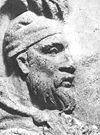
Dacian kings: Culture and civilisation: Art, jewellery, treasures, tools (Bracelets) · Clothing · Foreign Relations (Greeks · Celts · Romans · Germanic tribes) · Warfare (Falx · Sica · Thracian warfare)
Sarmizegetusa · Argidava · Buridava · Cumidava · Piroboridava · Sucidava · More towns... · Davae · Dacian Fortresses of the Orăştie Mountains · Murus dacicusWars with the
Roman Empire:Roman Dacia: Dacia Traiana · Moesia · Scythia Minor · Dacia Aureliana · Diocese of Dacia · Dacia Mediterranea · Dacia Ripensis · Trajan (Bridge · Column) · Towns and cities · Castra · Limes (Alutanus · Moesiae · Porolissensis · Sarmatiae · Transalutanus · Trajan's Wall · Brazda lui Novac) · Language (Thraco-Roman · Eastern Romance substratum)Research on Dacia: Books about Dacia · Dacian archaeology · Archaeological sites in Romania · Dacology · Thracology · ProtochronismWikiProject • Commons • Dacian fortresses, settlements, Roman castra, limes from Romania: Google Maps • Google EarthCategories:- Articles to be expanded with sources
- Dacia
- Military equipment
- Warfare of the Ancient era
- Dragons
Wikimedia Foundation. 2010.

